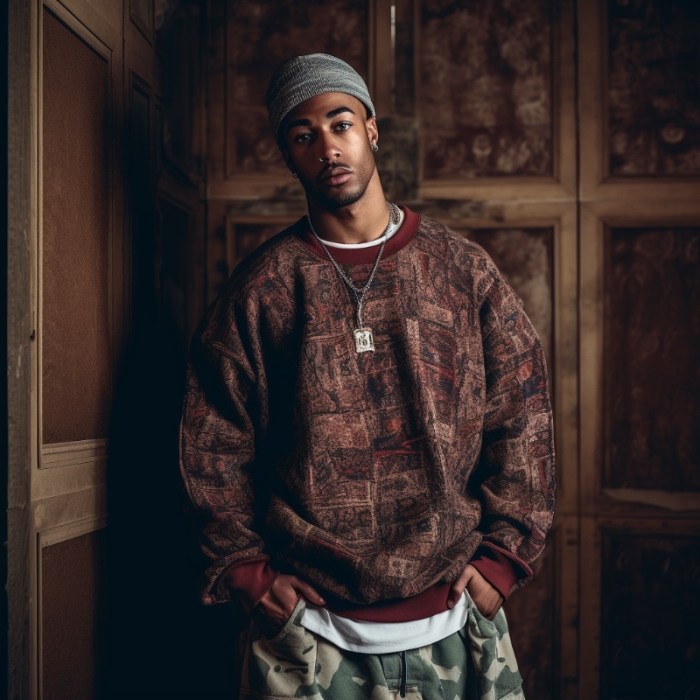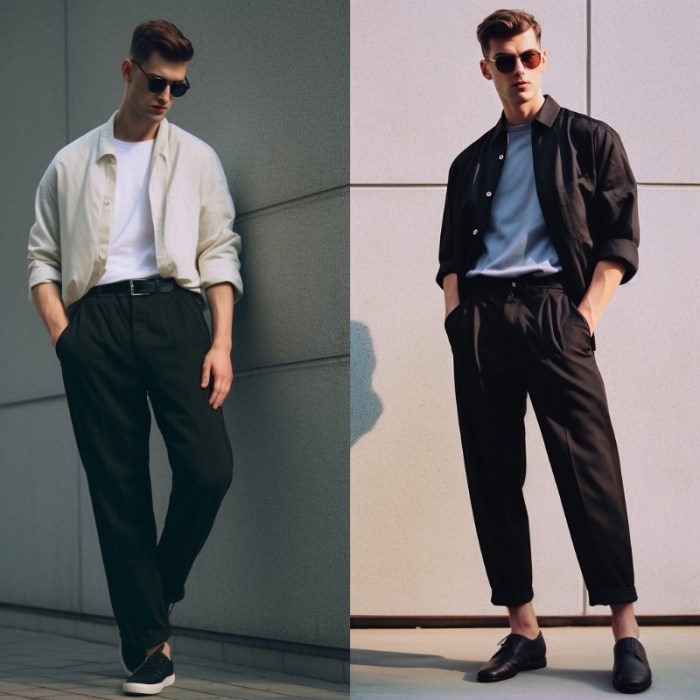Mens Fashion 2001 A Retrospective
Men’s Fashion Trends of 2001: Men’s Fashion 2001
Men’s fashion 2001 – The year 2001 presented a fascinating blend of lingering 90s styles and emerging trends that would shape the following decade. Men’s fashion saw a shift away from the grunge and oversized looks of the late 90s, embracing a more streamlined and sometimes preppy aesthetic. This evolution was influenced by various cultural factors and celebrity endorsements, resulting in a diverse range of styles.
Dominant Silhouettes and Cuts
Silhouettes were generally slimmer than the baggy styles of the previous decade. Fitted shirts, tailored trousers, and more form-fitting jackets were prevalent. The “low-rise” jean trend, popularized in the late 90s, continued its reign, though a slight shift towards a more regular rise was also observable. This created a more balanced and sophisticated look compared to the extreme low-rise jeans of the late 90s.
Key Colors and Patterns
The color palette of 2001 men’s fashion leaned towards muted tones and classic combinations. Neutral shades like navy, khaki, gray, and black were staples. Earthy tones such as olive green and brown were also popular. Patterns were relatively understated, with subtle stripes, checks, and solid colors dominating. Camouflage patterns, though having roots in earlier decades, continued to be seen, particularly in casual wear.
Popular Fabrics
Common fabrics included cotton, denim, wool, and corduroy. Lightweight cotton blends were popular for shirts and casual wear, while heavier wool and corduroy were favored for jackets and trousers, reflecting a move towards more structured clothing. Denim remained a staple, though washes and treatments varied from light and faded to darker, richer shades.
Men’s Fashion Across Age Groups in 2001
| Age Group | Dominant Styles | Key Colors | Notable Accessories |
|---|---|---|---|
| Teenagers/Young Adults (15-25) | Low-rise jeans, graphic tees, baggy skater-style pants, hoodies, baseball caps | Black, dark wash denim, bright accent colors (neon, etc.), camouflage | Baseball caps, skate shoes, chunky necklaces, studded belts |
| Young Professionals (25-35) | Fitted shirts, tailored trousers, blazers, button-down shirts, chinos | Navy, gray, khaki, brown, black | Leather belts, dress shoes, watches, briefcases |
| Older Men (35+) | Classic suits, button-down shirts, loafers, cardigans, denim (more relaxed fits than younger generations) | Neutral tones, subtle patterns (stripes, checks) | Leather belts, dress shoes, simple watches |
Iconic Styles and Influencers of 2001 Men’s Fashion

Source: thefashionisto.com
The influence of media and celebrity culture played a significant role in shaping men’s fashion choices in 2001. Movies, television shows, and music icons contributed to the trends that defined the year.
Impact of Media
Movies like “The Fast and the Furious” (2001) showcased a particular style featuring baggy clothing, fitted shirts layered under jackets, and a focus on athletic and street-inspired looks. Television shows reflected a similar trend, influencing the adoption of certain styles among younger audiences.
Influence of Musicians and Celebrities
Musicians like Eminem and rappers in the early 2000s hip-hop scene influenced trends with their baggy clothing, often paired with bold accessories and streetwear elements. Celebrities like Leonardo DiCaprio and Jude Law, known for their more classic and tailored styles, also contributed to the broader spectrum of men’s fashion in 2001.
Popular Clothing Items and Styles
Low-rise jeans remained incredibly popular, fuelled by media portrayals and celebrity endorsements. Fitted button-down shirts, often worn with tailored trousers or chinos, became a staple for a more sophisticated look. Hoodies and graphic tees retained popularity, especially among younger demographics.
Style of a Leading Male Fashion Icon: A Text-Based Description
Consider the style of a leading male fashion icon, say, a stylized representation of a young professional in 2001: He might be seen wearing a well-tailored navy blazer over a crisp white button-down shirt, paired with dark-wash, straight-leg jeans and polished brown leather loafers. A simple leather belt, a classic wristwatch, and perhaps a subtle silver chain necklace complete the look.
The overall aesthetic is clean, sophisticated, and effortlessly cool, reflecting a blend of classic and contemporary styles prevalent during that time.
Men’s Accessories and Footwear in 2001
Accessories and footwear played a crucial role in completing the overall look of men’s fashion in 2001. The choices reflected the diverse styles and subcultures of the time.
Popular Footwear

Source: apetogentleman.com
Sneakers, particularly skate shoes and athletic footwear, were popular among younger men. Loafers and dress shoes were favored for more formal occasions. Boots, particularly work boots and chukka boots, were also part of the landscape, especially in more casual settings.
Key Accessories

Source: thefashionisto.com
Leather belts, often with simple buckles, were a staple. Watches, ranging from classic styles to more sporty designs, were widely worn. Jewelry was less prominent than in some other eras, but simple necklaces and bracelets were sometimes seen.
Accessories Across Subcultures, Men’s fashion 2001
Subcultures influenced accessory choices. For instance, those within the hip-hop scene might have favored bolder chains and rings, while those in more preppy or professional circles might have preferred more understated accessories.
Popular Men’s Belts and Shoes
- Leather belts: Black, brown, and dark-colored leather belts with simple buckles were common.
- Canvas belts: These were also seen, especially in casual settings.
- Leather shoes: Loafers, dress shoes, and boots in leather were popular.
- Canvas shoes: Sneakers and canvas shoes were common in casual wear.
Evolution of Men’s Fashion: Late 1990s to 2001
The transition from the late 1990s to 2001 in men’s fashion marked a shift from the grunge and oversized styles of the previous era to a more streamlined and tailored aesthetic. This evolution was influenced by changing cultural trends and a desire for a more refined look.
Transition in Styles
The baggy jeans and oversized shirts of the late 90s gradually gave way to slimmer fits and more structured clothing. The influence of hip-hop fashion, while still present, began to integrate with more classic styles. This resulted in a more diverse and blended approach to men’s clothing.
Cultural Influences
Cultural shifts and social events played a role. The rise of hip-hop culture continued to influence fashion, but a simultaneous move toward a more refined and sophisticated style became noticeable, perhaps reflecting a broader cultural shift in values and aesthetics.
Men’s fashion in 2001 saw a resurgence of classic styles, often with a slightly more relaxed fit than previous decades. The evolution of menswear continued thirteen years later, as evidenced by the significant shifts in trends documented in fashion styles for men 2014. This period showcased a bolder approach to layering and accessorizing, contrasting sharply with the sometimes simpler silhouettes of 2001.
Comparison of Styles
The key differences lay in the fit and silhouette. Oversized, baggy styles gave way to more tailored and fitted options. Colors remained diverse, but there was a movement towards more muted and classic tones in 2001 compared to the sometimes brighter and bolder choices of the late 90s.
Comparison of Specific Clothing Items
| Clothing Item | Late 1990s | 2001 |
|---|---|---|
| Jeans | Baggy, low-rise, often faded or distressed denim | Straight-leg or slightly boot-cut, low-rise to regular rise, darker washes |
| Shirts | Oversized, graphic tees, flannel shirts | Fitted button-down shirts, henleys, polos |
| Jackets | Oversized denim jackets, bomber jackets | Tailored blazers, leather jackets (more fitted styles) |
Key Questions Answered
What were some popular hairstyles for men in 2001?
Popular hairstyles included short, textured cuts, often styled with gel or pomade. Longer hair was also seen, sometimes styled with layers or swept back.
How did the rise of technology influence men’s fashion in 2001?
The burgeoning tech industry subtly influenced fashion with the adoption of more casual and comfortable clothing options in some sectors, reflecting a more relaxed workplace environment in certain industries.
Were there any significant fashion controversies in 2001?
While not major controversies, debates around the appropriateness of certain casual styles in more formal settings were prevalent, mirroring broader discussions about evolving workplace norms.





















